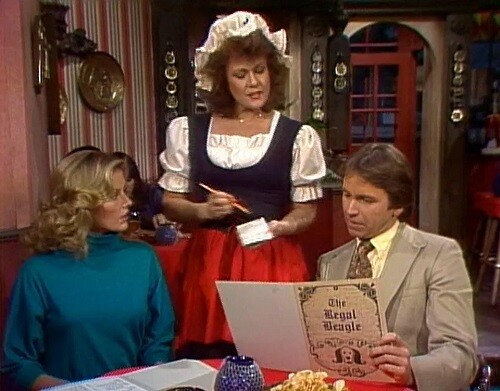The Devolution Of Sitcom Bars (Cheers To Moe's To Paddy's Pub)

Every sitcom needs a hangout spot: somewhere where the characters can meet and discuss the latest goings on in their lives, because no one in these things has ever heard of a group chat. Bars are a popular location choice among sitcom makers, possibly because establishing that their characters are frequent drinkers makes some of their decisions somewhat more realistic -- but this wasn't always the case.
The early sitcoms from the 1950s favored places like malt shops (Our Miss Brooks), swanky nightclubs (I Love Lucy), or just having the characters stay at home like completely losers (Leave It to Beaver). One exception was 1954's Duffy's Tavern, based on a long-running radio show about a wisecracking bartender whose name, in a transgressive plot twist that must have blown everyone's minds back then, wasn't Duffy (the actual Duffy never appeared). Perhaps this was too revolutionary, though, because the sitcom only lasted one season. America wasn't ready for a bar in prime time television yet.
Don't Miss
Nearly two decades would have to go by before a bar became a recurrent location in a popular sitcom: the racist, sexist, and misanthropic Archie Bunker from All in the Family, a.k.a. proto-Cartman from South Park, frequented a bar that was either called Kelsey's or Kelcy's, depending on the episode. The owner was such a drunkard that he couldn't even keep the name straight. The show implied that this was not a place high class, discerning patrons would ever step into; why, they'll even let some of those "alternative lifestyle" people in!
But it actually looks like a pretty nice and clean establishment, especially after Archie buys it and turns it into a successful restaurant. Meanwhile, the Korean War-era army doctors in M*A*S*H hanged in two bars, the Officer's Club and Rosie's Bar, which they could probably get away with because it would have been kind of hard to justify the existence of a '50s-type diner (like the one in Happy Days) in the middle of Korea.
Three's Company had the Regal Beagle, a bar that was sometimes treated like a place where dangerous types might dwell, but again, no one told the set designer. This looks like one of those fancy joints where they won't let you in unless you're wearing a tie and both shoes.

DLT Entertainment
The next step in the evolution of the sitcom bar came when the son of Duffy's Tavern co-creator Abe Burrows came up with a bar show of his own, along with writers Glen and Les Charles: Cheers, best known to Millennials as that show you try to sit through when you run out of Frasier episodes.
This was a somewhat more realistic depiction of a bar compared to what we'd seen on TV before, complete with the occasional acknowledgement that sometimes, people who hang out at bars every day have addiction issues. Even Frasier started hitting the bottle too much at one point, although he never went through anything as dramatic as the mini metal breakdown Norm suffers when he finds out someone else has dared to sit on his stool.
Cheers was a big hit, and what do you know, suddenly every comedy show wanted a bar hangout. There's Moe's from The Simpsons, which was also influenced by Duffy's Tavern: in an early episode, Moe answers the phone using Duffy's catchphrase ("Moe's Tavern, where the elite meet to drink"), only to devolve into insults once he realizes "Mike Rotch" isn't a real person.
It's ironic that a cartoon was the first American show to really capture the depressing atmosphere of an actual bar. There's nothing glamorous about this one, discounting temporary remodelings as family entertainment centers or gay nightclubs. The trend of using seedier hangout spots continued in Married with Children, which featured the characters visiting (and even getting jobs at) various nudie bars.
Home Improvement had Big Mike's, a bar full of rowdy macho dudes who think there's nothing less manly than going home early to have sex with your wife. Hell, even Boy Meets World uses a bar-looking "restaurant" called Chubbie's as the designated hangout spot, despite the fact that the characters are teens. The actor playing Chubbie changed partway through the show, possibly after the character had reconstructive surgery to avoid fines.
Similarly, The Drew Carey Show featured a recurring bar called the Warsaw which, and we quote, "serves alcohol to high school students, holds cockfights in the back room," and whose owner was eventually arrested for slipping booze into everyone's food as part of a prank. Even worse, it forced us to think about Drew Carey's ... package in the following scene:
Family Guy has the Drunken Clam, which has seen more fights and devastation than some European countries. We cannot fault the owner for savagely beating up Peter Griffith.
And this crescendo of nastiness inevitably leads us to It's Always Sunny in Philadelphia, which isn't just set in a bar: the characters themselves are like personifications of the crappiest bar you can imagine. Even when the action takes them away from Paddy's or when they haven't done anything remotely related to running a bar for entire episodes, the show still feels like the sticky floor of a poorly maintained pub bathroom. And yet they get great reviews!
After Always Sunny, there's really not many more places to take the sitcom bar, so we're not surprised that there haven't been any innovations in this area for the past decade and a half -- with the exception, perhaps, of the supervillain bar in Harley Quinn, which is getting its own spin-off soon (assuming Warner Bros. Discovery hasn't killed it before it even aired).
Meanwhile, other sitcoms have been staying away from the bar trope for some time -- The Big Bang Theory used a Cheesecake Factory as the hangout spot, for Darkseid's sake. It would be a shame if Always Sunny's success signaled the end of this long TV tradition. After all ...
Follow Maxwell Yezpitelok's heroic effort to read and comment on every '90s Superman comic at Superman86to99.tumblr.com.
Thumbnail: CBS Television Distribution, Disney-ABC Domestic Television